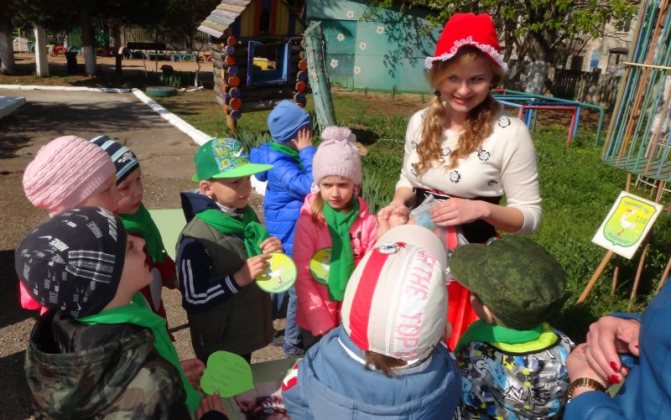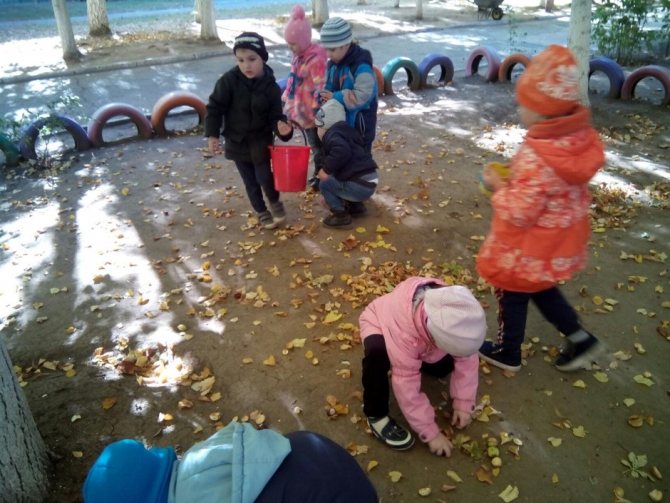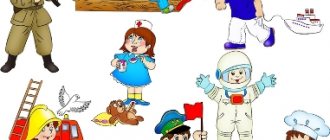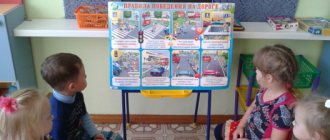Organization of environmental projects
For environmental projects in different groups, it is preferable to choose topics related to the native land. Observations and experiments that are carried out in real conditions will bring more benefits than those that the child watches a video about or reads about in a book. The development of project activities goes through three age stages.
In younger groups
The beginning of the first stage refers to the age of 3–4 years. Search activity is natural for children. They explore the world, they are interested in everything. Starting from the age of three, they use this type of work as an environmental project. The leading role still belongs to the adult. Teachers usually choose practice-oriented, game projects. Environmental education begins with the immediate environment. Let the kids look at what flowers grow in their flowerbed and watch the insects. At 3–4 years old, any little thing encountered on the street is a discovery.
The theme "Native Trees" is suitable for this age group. As part of the project activity, kids will learn what deciduous and coniferous species grow in the yard. They will observe when the leaves appear, what color they are, and what happens to them in the fall. Different forms are used:
- an adult's story;
- conversation;
- excursion;
- observation;
- walk;
- Reading books;
- viewing photographs, pictures, reproductions;
- watching videos;
- acquaintance with folklore.
In a kindergarten setting, group projects are chosen for 3-4 year olds.
In middle groups
The second stage begins at the age of four. Students become more independent, and the goals of the project become more complex. Life experience does not yet allow one to show independence in choosing a problem; activity proceeds at an imitative-executive level.
Important! Students can act as “customers” of the project, asking questions of interest.
Forms and methods of research activity are moving to a new level. Work on the topic “Flora of my region” includes activities such as collecting a herbarium and compiling a photo album. Co-creation between children and adults is a mandatory component of the project.
Family project
Pupils can engage in socially significant activities. They don’t just observe what flowers grow in the flowerbed, but they themselves plant a flower garden. Working on the theme “Our Flowerbed,” the kids get to know the flowers and choose which ones will grow in their area. Together with adults, they will sow seeds and wait for germination. The result is a beautiful blooming flowerbed that they will be proud to show to their friends and relatives.
Environmental education at school taking into account the Federal State Educational Standard
The study of spectral colors can be carried out in the form of a project activity by choosing the theme “Rainbow”. By the age of 4-5, kids should know the basic colors, this project will take them further. They will get acquainted with shades and learn what colors are obtained when mixing paints. During the work, they will become familiar with the concept of spectrum, learn poems and songs, and conduct scientific experiments.
For older groups
As they get older, social experience accumulates and students begin to cooperate with each other. It's time for paired projects. At the psychological level, noticeable changes occur: the ability to self-control appears, impulsive impulses become less frequent, and self-esteem develops.
The senior group uses different types of projects:
- research;
- creative;
- role-playing
Important! An environmental project in the senior group provides for organizational initiative on the part of students.
It is expected to develop the ability to find ways to solve a problem and develop the desire to use environmental terms in speech. The words “save the environment” are filled with meaning.

Excursion with Little Red Riding Hood
It would be appropriate to carry out the project “We are your children, Earth!” The teacher raises the problem of garbage in public places, explains why the forest is useful, what the “Red Book” is and what animals are listed in it. The planet takes care of earthlings like a mother, she feeds, clothes, gives warmth and beauty, and they must respond in kind.
In preparatory groups
The third stage of development of project activities refers to the preparatory group. It is characterized by a high level of interest, which is due to the development of cognitive abilities and personality traits. Adult activity gives way to support for children's initiative. An adult creates conditions for independent activity of pupils and organizes a cognitive space.
The ecology project in the preparatory group is of great importance for the development of the personality of students, as it involves the formation of ideas about the relationship between the natural environment and humans.
Note! Project activities have socially beneficial significance. Making bird feeders will allow you to feed the birds in winter. The plan may include events such as the release of leaflets, poetry readings, and a drawing competition.

Ecological landing
The projects pay great attention to the scientific basis. You can touch on the following questions: where do microbes come from? What is the harm from sewage? What is ice? What are north and south?
Book by Nikolaeva S.N. environmental education of preschool children - methodology
The result of project activities in the preparatory group should be the following:
- understanding the relationships in the natural environment;
- respect for the environment;
- development of basic environmental knowledge and culture of behavior;
- creation of a unified educational space for environmental education.
Pedagogical project on ecology for children of senior preschool age
Pedagogical project on environmental education for children of senior preschool age (5 - 7 years old) “The world around us...”
It’s not for nothing that children love fairy tales. After all, the good thing about a fairy tale is that the soul already anticipates a happy ending in it. Explanatory note Every person, being in early childhood, listened to fairy tales. For many centuries, folk tales played the same role in human life as books, magazines, newspapers, television, radio, the Internet and other common sources of information play in our time. The project provides an opportunity to develop observation and analysis of phenomena, comparison, generalization and the ability to draw conclusions, creative thinking, logic of knowledge, inquisitiveness of the mind, joint cognitive and research activities, communication and reflective skills, which are components of a successful personality. Promotes the development of independent thinking, helping the child to build confidence in himself and his own capabilities. Project activities of both teachers and preschoolers significantly change interpersonal relationships between peers and between adults and children. All participants in project activities gain experience in productive interaction, the ability to hear others and express their attitude to various aspects of reality. A new round of interest in the project as a way of organizing children’s life activities is explained by its potential integrativity, compliance with developmental education technology, and ensuring children’s activity in the educational process. RELEVANCE: The relevance of environmental education for preschoolers is due to the fact that interaction with nature has great psychological and pedagogical potential, which should be used in the process of environmental education, which allows it to become a factor in the overall formation and development of personality. The formation of a child’s personality and his upbringing begins with the education of feelings through the world of positive emotions. It is project activity that allows not only to support children’s initiative, but also to formalize it in the form of a culturally significant product. Today, environmental awareness and respect for nature have become the key to human survival on our planet. Environmental education for children is a huge potential for their comprehensive development. Bits of environmental knowledge acquired in childhood will help the child navigate the surrounding reality and understand it correctly. But most importantly, they will lay the foundation for a conscious attitude towards nature, determining one’s place in it in the future. PROJECT ABSTRACT: Long-term project - from January to October (2016) Project goal: To show one of the options for an integrated approach in the education of preschool children using the example of design and research activities and the importance of a diverse developmental environment for organizing project work. Project objectives: — Creating conditions for the development of creative abilities in children. — Involving parents in the implementation of the project. — Fostering a humane, emotionally positive, careful, caring attitude towards the natural world and the environment in general. — Formation of basic skills to foresee the consequences of some of their actions in relation to the environment. The project is built in accordance with the Federal State Educational Standard, taking into account the principle of integration of the educational field in accordance with age capabilities and the specifics of educational fields. Project participants: Preschoolers 5 - 7 years old, teaching staff of preschool educational institutions, parents (legal representatives) Developmental environment: Group rooms ("Fairy Tale Room", "Sensory Room", "Ecological Room"), music and physical education room, vegetable garden. Materials and equipment: Turnips and other vegetables (for comparison), “Wonderful bag” (to determine the shape of an object by touch), scales, magnifying glasses, illustrations of turnips, costumes and attributes of fairy tale heroes for the mummers’ corner, figurines of heroes for board games based on fairy tales, materials for creative visual activities, turnip seeds, containers, equipment for planting plants indoors and in the garden and caring for them, a geographical map, turnip symbol icons for attaching to the map, video film, watching cartoons. Literature : Fairy tales - “Turnip”, “The Man and the Bear”, N. Nosov “Turnip”, riddles, sayings, proverbs, nursery rhymes, poems, songs.
Project Implementation Plan
PREPARATORY STAGE Activities of the teacher • Creation of conditions • Selection of equipment and materials • Motivating children to understand the integrity and value of the world around them. Motivating children for cognitive and research activities • Conversation with children about what they will do as part of the project Children's activities • Arousing interest in the natural world around them • Awareness and comprehension of the relevance and purpose of the activity, manifestation of cognitive interest • Examination of illustrations, paintings • Reading and discussion fairy tales, works, riddles, proverbs, sayings, nursery rhymes • Working with a geographic map • Making turnip symbols for placement on a geographic map
MAIN STAGE
Activities of the teacher • Motivating children for cognitive activity • Activating children's attention by including them in cognitive environmental activities, forming elementary knowledge in children Activities of children • Accumulating information • Visual activity; Drawing, modeling, appliqué (origami) • Introducing children to the taste of turnips. Turnip dishes. History of turnips in Rus'. • Didactic games (“Wonderful bag”), Relay game “The Fastest” (in the hall) • Learning poems, songs about the TURNIP - Dramatization of the fairy tale “Turnip” with roles. Independent acting out of a fairy tale in costumes - Theatrical games with figures of fairy tale heroes • At home, together with your parents, plant a turnip and observe it, making notes of the results • Watching the cartoons “Turnip”, “The Man and the Bear”. Discussion of plots • Watching the video “How the sprout appeared.” Discussion Preparing for research and performing various studies • Examining seeds under a magnifying glass, planting seedlings, observation Researching turnips: - Shape, taste, surface, examining seeds through a magnifying glass, examining the root crop (root - through it the plant receives water and food from the ground), leaves at the shoots. Weighing turnips Experiments with turnips: - Place different vegetables in a container with water, find out which vegetables sink in water and which don’t - Cut the turnip into several parts and place them in different places: near the radiator (where it’s warm), at room temperature in a group and in a cold place (between frames, in the refrigerator) - Children observe and draw conclusions • Soil research: examining the inhabitants - bugs, worms. • Experiment with soil: “Is there air in the ground” (If we lower the soil into a transparent container with water, we see that bubbles appear - this is air, which means there is air in the ground (soil))
THE FINAL STAGE
Activities of the teacher • Stimulating children to self-analysis and self-evaluation of their activities • Help in formulating conclusions • Summing up Children's activities • Harvesting.
Exhibition of works • Collective work “OUR HARVEST” (application) • Festive event Expected result: 1. A unified system for developing the moral qualities of a preschooler’s personality will be formed through environmental education based on the principle of continuity of all links of the educational chain. 2. A developmental environment will be organized that will promote the moral and environmental development of children. 3. A functional model of greening preschool children, a system of criteria and indicators for assessing the formation of their value orientations will be developed and implemented. 4. A didactic complex will be developed (synopses of direct educational activities, entertainment scenarios, didactic games, manuals)
We recommend watching:
An ecological fairy tale about the water cycle in nature for children aged 5-7 years. Summary of a conversation with children of the older group. Topic: Energy saving Scenario for an environmental holiday in kindergarten. Senior preparatory group Ecology quiz game for kindergarten. Senior group
Similar articles:
Summary of a comprehensive lesson for children 5-6 years old on the topic “Take care of the forest”
Ecological holidays and leisure activities in preschool educational institutions. Scenarios
Ecological holiday "Earth Day" at the preschool educational institution. Senior group
Ecology classes in the senior group of kindergarten


